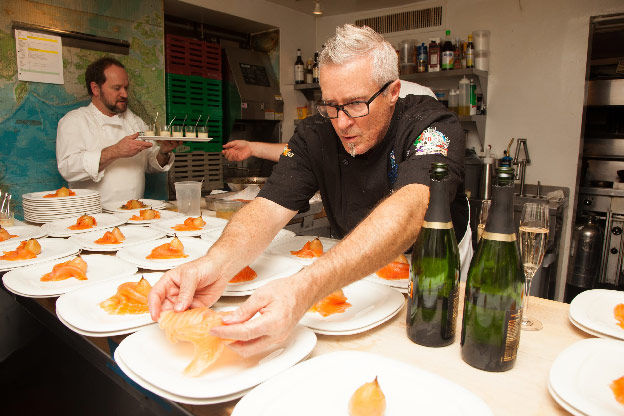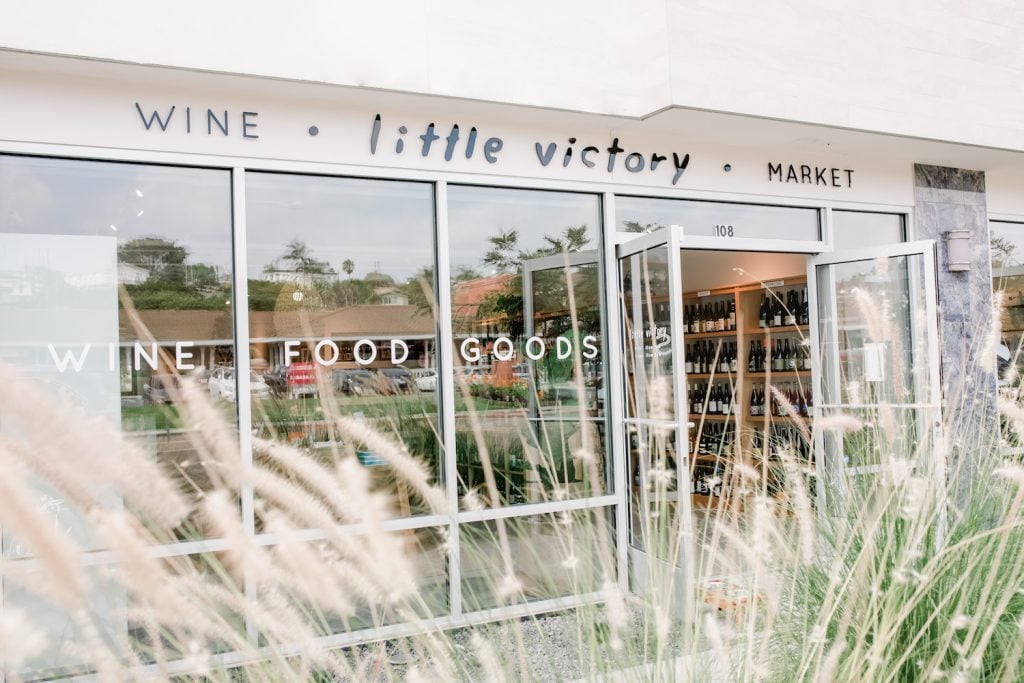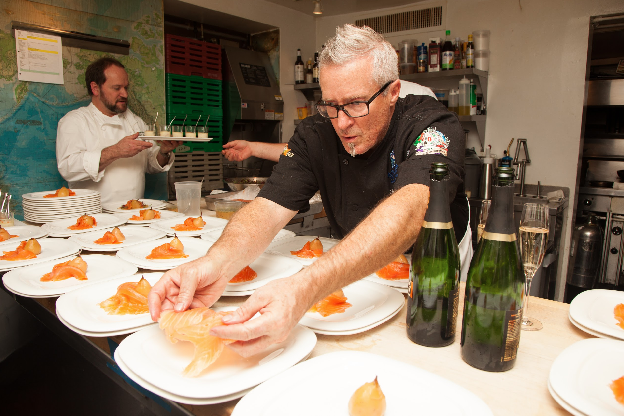
Patrick Glennon
Patrick Glennon
“Do you know who he is?”
People often whisper this when talking about Patrick Glennon. As vice president of sales for Santa Monica Seafood, Glennon is one of the foremost sustainable seafood experts in the country. That’s accomplishment enough. But a few months ago, he posted photos of his trip to cook at the James Beard House. Then he competed on Alton Brown’s Food Network show, Cutthroat Kitchen. He easily dispatched a few contestants, then barely (and debatably) lost in the finals.
How many fish salesmen cook at that level? Who exactly was Glennon? I started asking around. One local restaurant lifer explained: “Two decades ago, he was the Grant Achatz or William Bradley.”
Knowing both fishing and kitchen life, it’s not terribly surprising that two of the biggest names in San Diego seafood have this common thread: Booze, in life-withering amounts. Both Glennon and Tommy Gomes (Catalina Offshore) nearly drank themselves to death, got sober, then poured that once-misdirected energy into good, honest work until they became the faces of an industry. Glennon doesn’t live in San Diego, but as fishmonger to top chefs and hyperactive culinary activist, he’s in local kitchens every week. His name is synonymous with top-notch seafood.
“Paddy was telling me…” a chef might say of some new study on sustainable seafood. Or “I got Paddy barking in my ear about how there’s no way my diver scallops are actually diver scallops…” another will smile, knowing Glennon’s right.
Chefs trust Glennon because he was once one of the top up-and-coming chefs in the country. He trained in France under greats Alain Ducasse, Jacques Maximin and Bruno Cirino. An early pilot for the American version of Iron Chef was filmed at The Mirage in Vegas, featuring William Shatner as the host and Glennon as “the American chef” (the pilot was slated for TMC, but never aired). After a long, almost-famous run in SoCal that involved bribing cops, brandishing automatic weapons atop Mick Fleetwood’s restaurant, and some groundbreaking cooking—Glennon found himself hundreds of thousands in debt, working in a fish freezer for minimum wage, and reeking of booze.
This is how one of America’s most promising chefs lost everything, and fought his way back.
You trained under some French greats for eight years. You came back to America in the 80s as a hugely talented young chef and went to… Newport Beach?
Yeah. I was forbidden by the French guys to work for some of the top American chefs of that era, like Wolfgang Puck. They wanted me to use my training for myself and not to make those guys any bigger. The French guys considered the American chefs culinary thieves. Jean-Louis Palladin was in charge of placing me coming back from France. I stayed at the Watergate for a week and then—the biggest mistake I made—I told him I wanted to go back to Newport. I should’ve gone to Chicago or New York City. The pool of opportunity got small quick.
Where’d you cook in Southern California?
I was the chef de cuisine for Ritz-Carlton Four Seasons during the ’80s and early ’90s. I was also the chef for the Le Meridian hotel in Coronado. The Meridians were known to have the best restaurants in the country at the time. [Mister A’s longtime chef] Stéphane Voitzwinkler was there; he was part of the entourage of young cooks we brought over from France. Tim Connelly of [San Diego farm] Connelly Gardens grew everything for me. We had a tasting menu—people hadn’t seen that before. We had to explain it to them. We’d put anchovies on the plate and people would get mad because it’s bait food. We were way ahead of our time for San Diego and Top 5 Zagat in the country. [Top French chef] Michel Richard came down from L.A. with a group of 12 French chefs just to have a meal with us. In the kitchen it was all the Frenchies and me. We’d have our trucks already packed and ready to go—after dinner service we’d go across the border and surf in Mexico for the weekend. It was a different time.
Then you went Hollywood?
I got big money thrown at me to open this place in L.A. for one of the head models of Guess Jeans, called Bilboque. Stefan came with me. Iman, Madonna, Stallone, Rod Stewart—they were regulars. But even with all these celebrities and notoriety, it was very short-lived. They said my salary was $175K. But we weren’t seeing any money. After three months of not getting paid, we jacked all the equipment and sold it to pay my crew. I was fine with them not paying me, but not paying my crew? Irish carjack.
That’s where you hooked up with Jean-Francois Meteigner?
Jean Francois and I took over all the hotels owned by Severyn Ashkenazy—the Bel Age, Mondrian, Hermitage.
I heard there are celebrities in Los Angeles.
It was wild. We did Pamela and Tommy’s wedding at the Bel Age. I cooked in John Travolta’s home. Same with Guns N Roses. We cooked for New Kids on the Block, Sting, Vanilla Ice, the Stones. But then the recession hit. No one wanted to hire us because we were high-paid chefs during a recession. So I partnered with [longtime New York pastry shop owners] The Ferraras. They wanted to open restaurants in L.A. We had a small farm in Topanga where we lived and smoked pot and drank all day. We farmed at least 40 percent of the food we cooked. This is when alcohol started to catch up to me.
When that didn’t pan out, you teamed up with Mick Fleetwood?
Yeah. I partnered with Mick to open Fleetwood’s. I was chef-owner. We had a show on VH1 that was Mick jamming with everyone, like Marky Mark. Little Feat was our house band. But we ran into liquor license problems from the get-go. The grand jury thought we were mafia. They pulled our liquor license on a technicality that went back 40 years before we bought the building. We did Michael Jackson’s release party. We’d pay the fire and police department not to show up.
Sounds pretty above-board.
Pretty much all the business we were doing was illegal, since we didn’t have the license to gather or sell liquor. This was during the riots. When the riots happened, we were on the roof with semi-automatics.
From rock venue with semi-automatics you joined… Disney?
Mick and I were in “keep the lights on” mode. That’s when I left high-end cuisine and started chasing Cheesecake Factory style money. These guys came in one day and asked me to rebuild the spider Encounter restaurant at LAX with some Disney designers. That was fu**ing horrific. We rebuilt that with John Rivera Sedlar. I was still cooking on the line and in charge of everything else—working 100 hours a week and keeping myself numb with alcohol the entire time. I think that’s when I lost my culinary soul—and my soul, period. I don’t even remember those years. It was a decade of blur.
So you got out?
Yeah. I went to Vermont. My wife at the time was not mentally stable. I thought I’d find a nice place for her. I went to New England Culinary Institute, where I was chef-instructor for fine dining restaurants. I used to train and handpick the kids for Daniel and Le Cirque. I built my own seafood distribution business there called Paddy the Fishmonger—market, distributor, restaurant. Alcoholism took that down.
What lured you back?
I was on the golf course one day and the phone rang. It was Jean-François. He wanted me to take over L’Orangerie in Beverly Hills. They brought me in as a consultant with Ludo Lefebvre was in the kitchen.
What was the final straw for you as a professional chef?
I opened up Hollywood & Vine Diner with a group that was supposed to build-out concepts. The builder overshot the build-out by millions. We opened the doors with no money. I couldn’t be in another restaurant with no money. That was the end of my road with alcohol. I was blacking out. I couldn’t be on the line without alcohol.
How’d you get out?
My fish vendor said, “You’re better than this—let’s get you out of this industry.” I started working nights icing fish for minimum wage on the docks. I didn’t get sober right away, believe me. I finally got sober in 2005. I figure I was about a month from death. I thought I was done. Eventually, I worked my way up and became the fish monger to the star chefs.
You’ve become known as a “culinary activist”—an absolute bulldog about sustainable, eco-friendly seafood. Three things a consumer can do?
First, buy US-caught fish, which is all under sustainable management. It doesn’t mean that Georges Bank is going to be recovered, but it does mean that anything from that area is in a rehabilitating, science-based recovery program. Second, Look up your fish on Monterrey Bay Aquarium’s site, www.seafoodwatch.org. They even have an app now. Third, look for the MSC (Marine Stewardship Council) certification. You’ll see it in most stores, from Whole Foods to Costco and Wal-Mart. It’s a really well-managed, science-based organization.
What’s the worst (most unsustainable) fish that people buy way too often?
Improperly farmed salmon. It’ll say “Atlantic salmon.” But unless the menu or the store is specific about the actual farm it came from, it’s most likely not from a sustainable farm. Chefs pay a premium for sustainably farmed fish—so they’re gonna put the name on the label or menu. They wouldn’t try to sell you a Cadillac by calling it “a car.” So “Atlantic salmon” basically means the same thing as “car.” It means nothing. If it says the farm, good chance it’s a sustainable operation.
What’s the biggest form of seafood fraud you see?
Mixing species. Sometimes a restaurant might call it grouper or sole on the menu, but it’s really swai—a Vietnamese catfish from Mekong River waters I wouldn’t drink. It’s often the seafood company who’s lying to the chefs, so it’s my job to try to educate them without “schooling” them. For instance, I’ll be bidding to sell a chef No. 1 ahi tuna and they’ll say ‘No thanks, I’m getting an insanely good price.’ I’ll have them take me to the walk-in cooler and show me the fish. It’s almost never No. 1 ahi. Or the chef thinks they’re getting Loch Duart salmon, but what they’re getting is actually Canadian salmon. If the fish was sold to them whole, they’d be able to tell by looking at it. But in filet form, it’s hard to tell them apart unless you taste it. So sellers can mislabel it and sell it for a higher price. A program such as MSC is a good way to insure what they are getting. Another big one is “diver scallops.” The amount of diver scallops that are actually caught by a diver is less than nothing and most of that stays in the fishing community. Plus, it’s seasonal. Divers aren’t going to go out in the Atlantic Ocean from late October to the beginning of April. Even “day boat scallops”—there are a very limited number of day boats.
Intentional fraud, or ignorance?
I’d say it’s 50/50 the guys who claim to be sustainable really are doing it right, and the others are just saying they are to make you feel good. A lot of big corporate restaurants will put one or two sustainable, farm-specific items on the menu to make you feel good. But the other 99 percent of the menu is unsustainable.
Your sausage company, Europa Specialty Sausage, is served in Whole Foods and Caesar’s Palace, St. Regis Monarch. Why aren’t you retired driving a sausage-shaped speedboat in the Caymans right now?
It’s not so profitable when you have six kids. My final run in the restaurant business, took me into the couple hundred thousand in tax debt.
Were you hesitant to start cooking again?
In the end, a voice spoke to me and said, ‘If you cook for charity and environmental awareness, there’s a lot to be done.’ Everything I do is for straight charity—helping farmers, ranchers and fishermen survive. At the Beard House, I personally shook the hand of every farmer, fisherman or diver whose food we served. With each plate presentation, we included a bio for every one of them. We served Skuna Bay Salmon, which is Canada’s answer to top-end Scottish salmon. The farmers live on the water with the fish 24/7. They take the top farms, and then take the top of the top fish from those farms. The fish box is taped at the farm and not opened until the chef opens it at the restaurant. If you buy Scottish salmon, you have no idea if it’s salmon.
You don’t have a restaurant, you’re not trying to “make it” as a chef. Why cook on TV?
My number one driving force is protecting what’s left of our food source. I realized I needed a bigger soap box than just that of a sausage producer and salesperson. My initial thing was auditioning for Top Chef. I tried out three times. Each time I got near the final test and they’d ask what restaurant I cooked for. And I just cook for charity. They couldn’t quite get their heads around it.
How was the Cutthroat Kitchen experience?
It was great. I left with a bitter taste for about a week. I didn’t feel I lost in the finals. I think it was very hard for the editors of that show to make it look like I deserved to lose. Are you doing ridiculous shit? Absolutely. But you have to be able to cook. It was like WWE meets Iron Chef.
And the Beard House?
Man, that was it for me. It really came full circle. After alcohol got the best of me and 10 years later to be in that house cooking next to those awesome chefs—I proved to myself I’ve still got some tools left.
You’re working on a documentary film, too?
It’s called Hail, Caesar. It’s the journey of a Caesar salad and all the ingredients that are in it—GMOs, imported produce, to-go containers, the chemicals used to clean the plates. There are a lot of sustainability issues in just one single salad. There are tons of improperly purchased items in a restaurant. And the thing is—they don’t just sell it once. They sell that salad 3,000 times a year. The amount of waste, the chemicals they produce, the jobs they pull from the local economy and give to internationals… it’s massive.
Where does sleep fall in your value system?
My nickname used to be RPM. I don’t work 40-hour weeks. I talk to chefs at 11PM, and I talk to them at 5AM.
After all the years of hard living, how are you physically?
For as busted up as my body is, I work out five or six days a week, I fight in the masters division of amateur boxing. www.olddogboxing.com. We get 1,000 people at the fights. For me, to get my body to the level it’s at is a miracle—no matter how ‘off’ my metabolism will always be. I fight now with a martial arts world champion. He kicks the shit out of me, but I can handle it.














